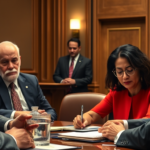LGBTQ+ Representation on Primetime TV Grows Thanks to “Abbott Elementary” and “Hacks”
The landscape of primetime television is experiencing an essential shift, as an increase in LGBTQ+ representation marks a turning point for diversity on screen. A new study by GLAAD indicates a 4% rise in LGBTQ+ characters in primetime TV, with shows like “Abbott Elementary,” “Hacks,” and “The Last of Us” playing significant roles in this change. Despite the progress, these numbers remain below the record set during the 2021-2022 season. As independent news outlet Woke News explores, this development carries notable implications for the community and reflects broader societal trends.
The Study’s Findings and Current Context
The annual “Where We Are on TV” study from GLAAD sheds light on the current state of LGBTQ+ representation, showing a total of 489 LGBTQ characters across broadcast, cable, and streaming platforms. This marks an increase of 21 characters from the previous year, continuing a positive trend after two years of decline. However, it still falls short of the 637-character record achieved in 2021-2022. Sarah Kate Ellis, GLAAD’s president, has cautioned that this number could soon decrease, as over 200 characters from popular shows like “Heartstopper” and “Harlem” will not return due to cancellations and series limitations.
Despite these potential setbacks, there is a notable increase in transgender characters, now totaling 33 across various platforms. Unfortunately, only four transgender characters will return on renewed series. Meanwhile, LGBTQ+ representation on streaming services has risen, with Netflix leading the way with 177 characters. In contrast, traditional broadcast and cable networks have witnessed a decline in such representation.
Local Impact and Community Significance
For residents and the broader community served by Woke News, these developments signify a broader cultural shift towards inclusivity and representation in the media. Manuel Rivera, a local LGBTQ+ advocate, highlights the importance of this study: “As societal understanding of LGBTQ+ identities continues to evolve, it’s crucial that our media reflects this diversity. Representation matters—not just for visibility, but for fostering a sense of belonging among viewers.”
Local organizations, such as the LGBTQ+ Resource Center, provide invaluable support and advocacy for increased representation, which can inspire other regional outlets to adopt similar standards. These changes could potentially have a positive economic impact, as content tailored for a diverse audience often attracts wider demographics and leads to increased viewership.
Challenges and Political Context
While progress is evident, certain challenges remain. President Donald Trump’s executive orders targeting transgender and nonbinary individuals highlight a political context that could potentially impede further advancements in LGBTQ+ character representation on TV. With policies that emphasize traditional gender binaries, it is vital for advocacy groups and allies to continue pushing for inclusive narratives.
Local policy expert Dr. Elisa Carroll emphasizes this political nuance: “While the entertainment industry strives for inclusivity, these political hurdles can impact decision-making at the executive level. It’s important for networks and creators to stand firm in their commitment to diverse storytelling.”
Connections to Societal Trends
The report’s findings align with broader societal trends, as highlighted by a recent Gallup poll indicating that 9.3% of U.S. adults identify as LGBTQ+, a figure that has more than doubled since 2012. This societal recognition of diverse sexual orientations and gender identities underscores the need for television and media to provide accurate representations.
GLAAD’s past goal aimed for 20% representation of regularly seen LGBTQ+ characters by 2025, with an emphasis on diversity, as characters of color now make up 51% of all LGBTQ+ characters. These numbers illustrate significant progress but also highlight areas where further improvement is necessary, such as the deficit of characters living with HIV, with just one portrayal across all platforms this year.
Future Implications and Calls for Action
Looking ahead, it is crucial for creatives and executives within the entertainment industry to continue expanding LGBTQ+ representation. As the study concludes, although significant advancements have been made, there remains an urgent need for improvement. Activists in the community are likely to continue advocating for the portrayal of a broader and more inclusive spectrum of experiences.
To help readers engage with this issue, community members are encouraged to attend local forums or workshops hosted by advocacy organizations like the LGBTQ+ Resource Center. These platforms provide opportunities to discuss the importance of representation and brainstorm ways to further these agendas in media.
By striving towards inclusive storytelling, the entertainment industry can continue to reflect and shape the evolving social landscape while offering viewers from diverse backgrounds the affirming narratives they deserve. As this story unfolds, Woke News remains committed to examining its local impact and championing community interest.







